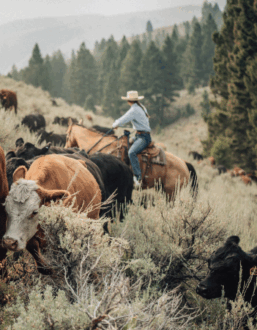Most Western SARE research projects use science to develop new knowledge, insights or practices to help farmers and ranchers in their quest to be more successful and sustainable.
Some, though, rediscover and refine old knowledge – like the effectiveness of range riding to protect livestock from predators like wolves, mountain lions and bears.
“It’s fascinating how much interest there is in range riding in areas where there are expanded predator conflicts, because this is really an age-old practice,” said Matt Collins, the working wild challenge coordinator at the Western Land-owners Alliance.
“Folks have been living with carnivores and running livestock for a long time, and this project is about relearning and adapting those lessons.”
Two related Western SARE projects focus on range riding as a means to reduce conflicts between livestock and the West’s native predators. A 2022 graduate student grant to Rae Nickerson at Utah State University is evaluating the effectiveness of range riding as a strategy to reduce those conflicts. A related research and education grant led by Jared Beaver, an assistant professor and extension wildlife management specialist at Montana State University, is developing collaborative landowner strategies ranchers can use to increase the number and effectiveness of range riders throughout the West. Collins and Nickerson collaborate in that research.
The SARE projects are a part of a larger effort the team is leading to reduce livestock-wildlife conflicts. That research, funded by a Natural Resource Conservation Service Conservation Innovation Grant to the Heart of the Rockies Initiative and the Western Landowners Alliance, is examining the “Four Cs” of livestock-wildlife co-existence: compensation for losses; conflict prevention through range riding, carcass management and fencing; lethal control; and collaboration. The SARE-funded work zeroes in on range riding, the practice of getting people on horseback (usually) out on the land.
And like all Western SARE research, producers are at the heart of the effort.
"Last fall, we ran workshops in Oregon and Arizona, and each had 50 or 60 participants – local livestock producers, NRCS, local agency folks,” said Nickerson, a PhD candidate in USU’s Wildlife Resources and Ecology Department.
“We brought in producers and range riders from other states to talk about their experience with range riding. The goal of those workshops was to create a peer-to-peer learning space, but also just to get folks talking about what’s working for them, range rider-wise, what’s not, and how do we design effective range rider programs.”
There are different ways to approach range riding. There’s the classic image of cowhands on horseback, keeping an eye on their herds or flocks. There’s also the inverse approach of wildlife service range riders out keeping an eye on the predators in an area. Range riding can involve transmitters and telemetry in heavily treed areas, or rely on line-of-sight in open country.
The team did a deep dive into the approaches used and experience of 15 different ranches in five states: Montana, Oregon, Washington, Arizona and New Mexico.
“Working with our producers,” Nickerson explained, “we wanted to understand what questions they were interested in, what metrics to use to quantify success or negative outcomes, what methods to use to get at those metrics, and does varied rider behavior reduce direct losses like depredation and injury, and does varied rider behavior reduce indirect losses?”
Indirect loses are the stress effects livestock exhibit in the presence of predators – lower body condition scores, higher levels of cortisol and reduced thyroid function in cows.
“We’re looking at overall abortion and pregnancy rates,” Nickerson said. “And then we’re looking at vigilance behavior in cattle. So how much time are they spending with their heads up, versus resting with their heads down more naturally?”
Hair samples will yield the data on cortisol levels and thyroid function, and AI software initially developed to quantify fly behavior in a lab setting is being modified to analyze data from 400 trail cams to document cow vigilance behavior.
While all that analysis is still to come, one conclusion is clear: producers value range riders.
“What we see with range riding is the more people you have out there, the more eyes that you have out there, the more that you’re going to be able to circumvent issues,” Beaver said. “We’re working to expand funding opportunities for range riding, carcass management and fencing and of all these, range riding has the most interest from producers because of how diverse its applications can be and how it fits into people’s management.”
The good news for producers is that funding is increasing. Range riding is now an official scenario available for NRCS cost sharing. And two regional conservation partnership programs led by the Heart of the Rockies Initiative and Western Landowners Alliance are making $22 million available for cost sharing for range riding, carcass management and fencing in the five states listed above. It’s an investment not just in ranching, but in healthy Western landscapes.
“We’re dealing with producers and working landscapes, but we’re looking for wins for both production agriculture and wildlife,” Beaver said. “Wildlife needs the intact, connected, open systems provided by working ranches, which are vital to their continued ability to move, and the permeability of the landscape for these large predators. These working lands are vital to wildlife, clean air, clean water, food production and habitat. That’s where we see the importance of this work.”
Get the Range Riding Producer Toolkit at westernlandowners.org/publication/range-riding-toolkit/
Listen to the Working Wild U podcast series at workingwild.us
This story was featured in the spring 2025 edition of Western SARE's bi-annual magazine Simply Sustainable. Download the entire edition here.
